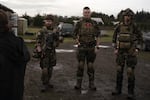Kneeling in a tree line on a foggy morning in Canby, Oregon, Alex Bates and Andrew Pollmann scan the woods for potential threats.
They’re decked out in tactical chest rigs to hold rifle magazines, Ops-Core helmets and Harris radios. This is the real gear soldiers use in combat, and they both look virtually indistinguishable from actual soldiers — except they're maybe a little cleaner.
Bates throws a purple smoke grenade. Then he, Pollmann and the rest of the Phantom Fury AirSoft team run into the woods, rifles at the ready.
They’re playing AirSoft, a simulated war game using rifles that shoot pellets a little smaller than a pea. The games often involve military tactics, and teams are organized like military units.
Of the roughly 20 people at Action Acres AirSoft today, only one is a woman. The owner of Action Acres, Lyla Gottman, said sometimes bachelorette parties will come, but it’s mostly a guy thing.

Noah Wenger, Andrew Pollmann, and Alex Bates listen to the rules before playing an AirSoft game at Action Acres AirSoft on March 23, 2019, in Canby, Ore.
Jonathan Levinson / OPB
That makes sense to Pollmann, because in his opinion, war is a male activity.
While women weren't officially given combat roles during the Iraq war, the unpredictable nature of those conflicts exposed many women to front line battle. In 2016, the Pentagon formally opened combat positions to women and they have since served in Afghanistan.
“I know they’re allowing women in Ranger bootcamp now,” said Pollmann. “I’m just like, no. It’s been the dawn of what males do since the beginning of time. It's our white male rage inside of us ....
“I definitely think there is something about violence that attracts males.”
Unattainable Masculinity
Pollmann's view of gender roles may sound brash, but it reflects a widely held view of masculinity often associated with strength. Men are supposed to be rugged. They're the protectors and breadwinners.
Miriam Abelson, an assistant professor of women, gender and sexuality studies at Portland State University, says these traits aren't coded into our biology.
“We have bodies, biology exists,” Abelson said. “But the meanings that get attached to those things and the kinds of differences that we see are largely social and environmental.”
Starting from a young age, boys feast on a steady diet of so-called manliness. That includes the pervasive image of a nuclear family and the attendant gender roles.
But it also includes pop culture imagery such as uber-warrior Rambo, who killed an estimated 503 people on screen, and Don Draper, the emotionally stunted — but successful — ad exec in "Mad Men."
Society's masculine ideal — a financially successful warrior who spends Sundays fixing the leaky faucet — is neither idyllic nor attainable in any real sense.
Eking out a middle-class income has become increasingly difficult. The days of men going off to conquer new land or defending the homestead from marauding bandits are largely in the past.
Abelson says society — that's men and women — establishes and reinforces these expectations.
“I think the key here is that everyone participates in our ideas about gender and our ideas about masculinity,” she said.
She adds that men will try to make up for their shortcomings in order to approximate the masculine ideal.

Andrew Pollmann wears his team patch and an infrared American flag on his clothes during an AirSoft game at Action Acres AirSoft on March 23, 2019, in Canby, Ore.
Jonathan Levinson / OPB
So after an economic downturn makes breadwinning more difficult, beards might become popular as a way to shore up rugged masculinity. Or, says Abelson, men might try to beef up their protector role to compensate.
Guns are a logical way to do that.
“We can think about ‘What do they represent in the U.S.?’ Independence. They represent protection and the capacity for violence,” Abelson said. “I wonder how something like AirSoft can be an outlet [...] that is a little bit more socially approved."
Abelson says a desire to protect others or to provide isn’t inherently bad. But the insecurity of not living up to society’s expectations can also present in harmful ways.
Things like domestic violence, racism, bar fights, road rage, homophobia, even workplace dynamics such as whose ideas get heard in a meeting, can all be negative manifestations of masculinity.
Violent Masculinity
Some of the most harmful behavior associated with masculinity impacts men the most.
Men and boys experience less nonviolent touch than women, something research shows leads to a host of negative impacts on mental and physical health. Cultures with less frequent affectionate touch between mothers and children are also more violent.
Gun violence is disproportionately perpetrated by and directed at men. Between 1980 and 2008, 90% of people convicted of homicide were men. In that same 28-year period, men made up almost 80% of homicide victims.
It's not just homicides either. Middle-age white males have the highest suicide rate, accounting for nearly 70% of suicides in 2017.
According to one study, gender is a better predictor for violent behavior than substance abuse. Another study concludes that being female gendered is a protective factor against violent behavior.
Even when men are able to fulfill an aspect of masculinity, huge voids can remain. A corporate job may satisfy the breadwinner role, but it doesn’t line up with any kind of warrior ideal.
So is playing war games or buying a gun an example of toxic masculinity? Maybe that’s not the best way to think about it.

Noah Wenger and Andrew Pollmann play AirSoft at Action Acres AirSoft on March 23, 2019, in Canby, Ore.
Jonathan Levinson / OPB
“It might be more important to look at … particular situations in particular places, what are men actually doing,” said Abelson.
Playing AirSoft as a way to get outside and spend time with friends is different from using it to to prove yourself as a warrior, as all that is man. And going to the gun range on the weekend is very different from, say, brandishing a handgun in order to assert dominance.
Rethinking Masculinity
Scott Luciano is walking to a local coffee shop in his Southeast Portland neighborhood. His rust-colored pants are cuffed just above his bare ankles, and his tattooed arms are basking in one of the first warm weekends of the year. He was spending his day preparing vegan meals for the week ahead.
Luciano isn’t from Portland, but he embodies a certain idea of the city.
Lately, he and his wife have been thinking about buying a gun for home security. But he doesn’t really see himself as the protector. His wife, he says, is fully capable of getting herself out of a dangerous situation. A gun would just be one way to help her do that.
“But same with me,” he said. “I think if a meth head broke into the house, am I stronger than him? Probably not. I would also like to have that leg up.”

Scott Luciano sits for a portrait on his front porch on May 4, 2019, in Portland, Ore.
Jonathan Levinson / OPB
Luciano added, “I don't have, like, a macho ‘Oh, if I'm here, everything's safe’ idea in my head.”
He and his wife challenge a lot of gender roles in their relationship, and at first, he says, that was hard for him. He was insecure, for example, that she had a college degree and made more money. She manages a lot of their finances, and he does a lot of the cooking and cleaning.
They’ve been together for 10 years, and he’s more comfortable with it now. Those aren’t things that define his manliness.
“You don't have to be this concept of your grandfather, this man that went to work and probably worked with steel all day and, you know, huffed black smoke,” Luciano said.
Maybe, he says, defining your masculinity is just about learning to be comfortable with who you are, which isn’t uniquely masculine at all.
Guns & America is a public media reporting project on the role of guns in American life.

